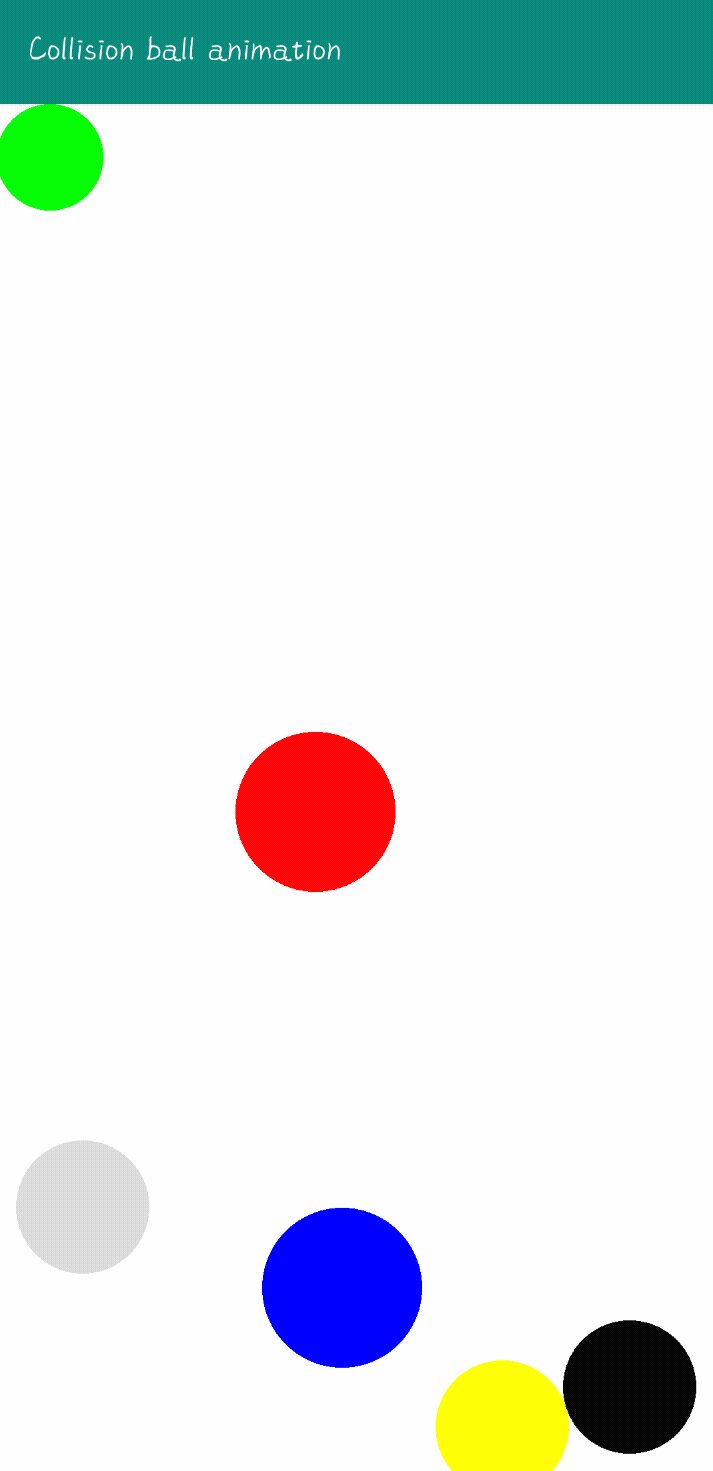Android之小球自由碰撞动画示例
目录
- 前言
- 1. add balls List
- 2.ball parameter
- 3. 判断是否有发生碰撞的小球
- 4.application display
前言
本文将基于Android对一个小球自由碰撞动画项目做一个简单介绍,并展示部分关键代码以及实际效果动态图
1. add balls List
添加颜色为绿,黄,红,黑,蓝,灰的小球,并设置其大小
ballList.add(new Ball(80, Color.GREEN, 700, width / 2, height / 2));
ballList.add(new Ball(100, Color.YELLOW, 600, width / 4 * 3, height / 4 * 3));
ballList.add(new Ball(120, Color.RED, 800, width / 3 * 3, height / 3 * 3));
ballList.add(new Ball(100, Color.BLACK, 800, width / 3 * 4, height / 3 * 4));
ballList.add(new Ball(120, Color.BLUE, 800, width / 5 * 3, height / 5 * 3));
ballList.add(new Ball(100, Color.DKGRAY, 800, width / 4 * 5, height / 5 * 4));
2.ball parameter
int radius; //半径大小
long speed =-1; //碰撞速度
int color; //颜色
long degree =-1; //初始方向值
int bgAlpha; //透明度
long lifeSpan =-1;
3. 判断是否有发生碰撞的小球
关键代码
private void checkoutBall() {
for (int i = 0; i < ballList.size(); i++) {
Ball ball1 = ballList.get(i);
Ball ball2 = (Ball) distanceMap.get(ball1);
if (ball2.getX() == -1 && ball2.getY() == -1) {
continue;
}
int distance2 = Math.abs(ball1.getX() - ball2.getX()) * Math.abs(ball1.getX() - ball2.getX())
+ Math.abs(ball1.getY() - ball2.getY()) * Math.abs(ball1.getY() - ball2.getY());
//最小距离小于阈值,发生碰撞 计算碰撞角度
if (distance2 <= (ball1.getRadius() + ball2.getRadius())
* (ball1.getRadius() + ball2.getRadius())) {
int x1 = ball1.getX();
int y1 = ball1.getY();
int x2 = ball2.getX();
int y2 = ball2.getY();
//两球的角度差为180 即两球正碰 交换运动方向
if (Math.abs(ball1.getDegree() - ball2.getDegree()) == 180) {
int temp = ball1.getDegree();
ball1.setDegree(ball2.getDegree());
ball2.setDegree(temp);
} else if (y1 == y2) {
//正弦值不存在 角度为90
if (x1 > x2) {
ball1.setDegree(90);
ball2.setDegree(270);
} else {
ball1.setDegree(270);
ball2.setDegree(90);
}
} else {
//斜碰 两球圆心连接线的角度做反向运动
float tan = (x1 - x2) / (y1 - y2);
//正弦对应的角度在[-90,90] 在这取绝对值让角度值为正值
int angle = (int) Math.abs(Math.atan(tan));
if (x1 > x2 && y1 > y2) {
//正弦值为正数 角度为[0,90] ball1在右下 ball2在左上
ball1.setDegree(angle + 90);
ball2.setDegree(angle + 270);
} else if (x1 > x2 && y1 < y2) {
//正弦值为负数 角度为[-90,0] ball1在右上 ball2在左下
ball1.setDegree(90 - angle);
ball2.setDegree(270 - angle);
} else if (x1 < x2 && y1 > y2) {
//正弦值为负数 角度为[-90,0] ball1在右下 ball2在左上
ball1.setDegree(270 - angle);
ball2.setDegree(90 - angle);
} else if (x1 < x2 && y1 < y2) {
//正弦值为正数 角度为[0,90] ball1在左上 ball2在右下
ball1.setDegree(angle + 270);
ball2.setDegree(angle + 90);
} else if (x1 == x1) {
//正弦值为0 angle为0
if (y1 > y2) {
ball1.setDegree(180);
ball2.setDegree(angle);
} else {
ball1.setDegree(angle);
ball2.setDegree(180);
}
}
}
//发生碰撞 重新初始化数据
distanceMap.put(ball2, new Ball());
distanceMap.put(ball1, new Ball());
}
}
}
1.collision detection

2.碰撞后重新调用onDraw(绘制小球)
private class MyThread extends Thread {
@Override
public void run() {
while (true) {
actionBall();
postInvalidate(); // 更新界面,重新调用onDraw()
try {
// sleep(1000 / 36);
sleep(10);
} catch (Exception e) {
e.printStackTrace();
}
}
}
}
onDraw
protected void onDraw(Canvas canvas) {
super.onDraw(canvas);
for (int i = 0; i < ballList.size(); i++) {
Ball ball = ballList.get(i);
Paint paint = new Paint();
paint.setColor(ball.getColor());
paint.setAlpha(ball.getAlpha());
paint.setStyle(Paint.Style.FILL);
paint.setStrokeWidth(1);
canvas.drawCircle(ball.getX(), ball.getY(), ball.getRadius(), paint);
}
}
4.application display
1.静态界面

2.动态效果图

到此这篇关于Android之小球自由碰撞动画示例的文章就介绍到这了,更多相关Android小球自由碰撞动画内容请搜索我们以前的文章或继续浏览下面的相关文章希望大家以后多多支持我们!
赞 (0)

